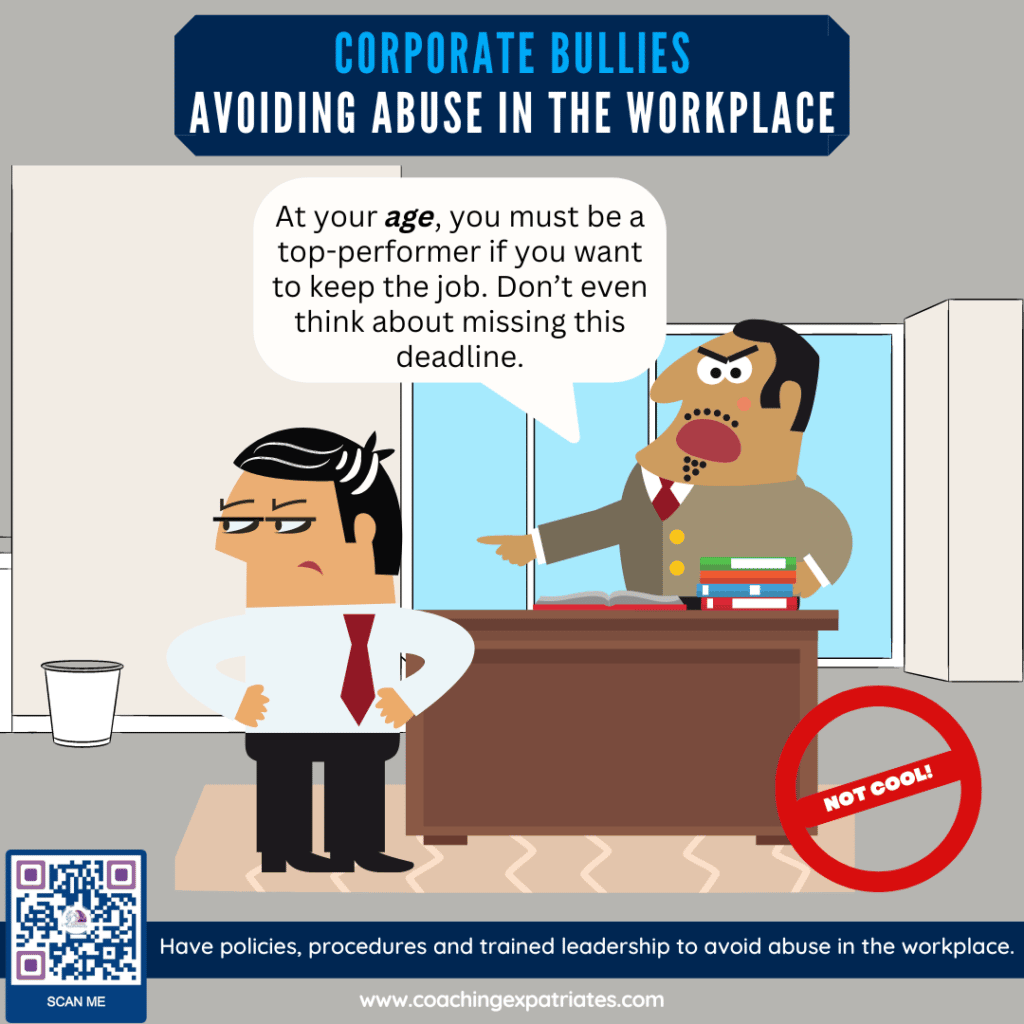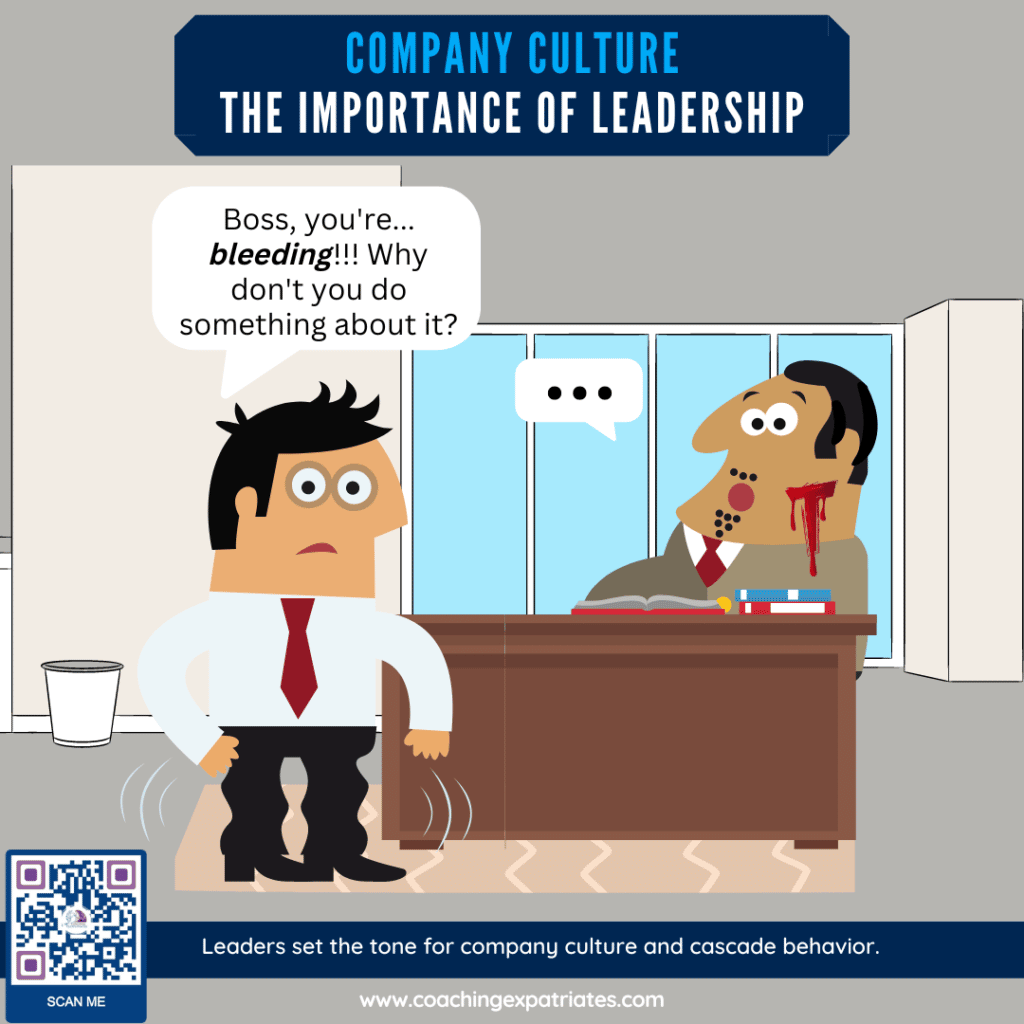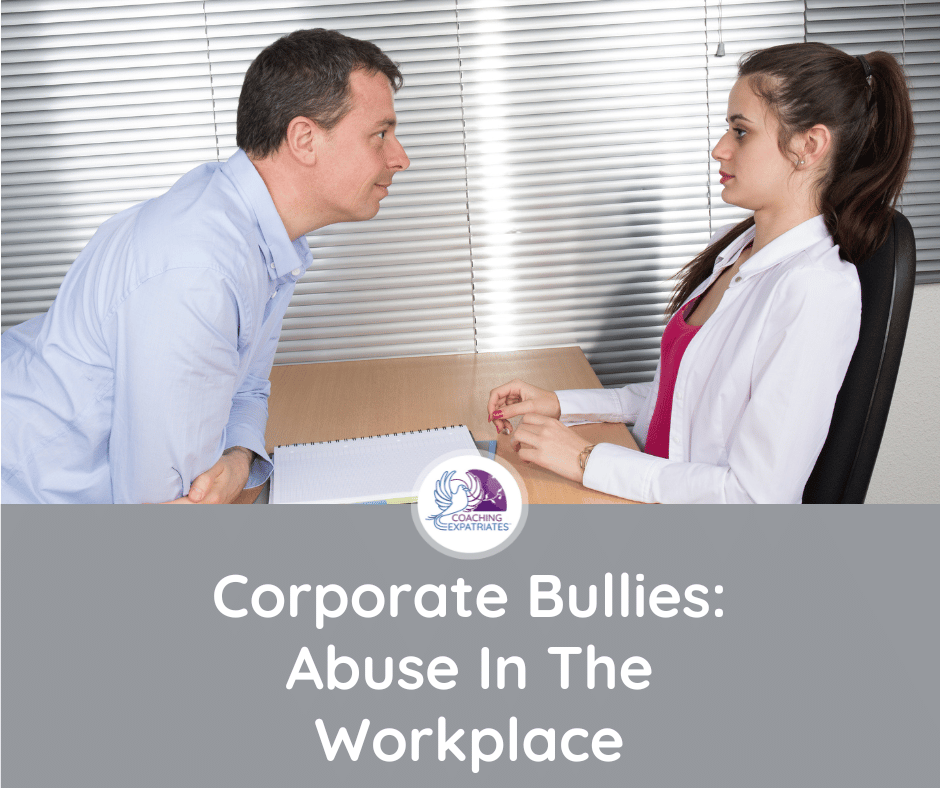With the increase in DEI (Diversity, Equity, Inclusion) topics, we see more and more companies implement Anti-harassment policies and procedures to combat abuse in the workplace as part of their global leadership pillars. In this article, we will talk about what abuse in the workplace is, what the bullies’ main traits are, why it still happens even with policies in place, and how we can effectively change reality in corporations to have healthier cultures in place.

If you are here, you are the type of exceptional global leader who care about your corporate culture and the work environment. If you are an individual contributor, a functional manager, the CHRO, or even the CEO, you can contribute to having a better corporate culture with less abuse in the workplace.
Being Oblivious To Abuse In The Workplace
I attended a strategy call with a prospect from a VERY big company. I was very excited about the call to see how I could help them.
It turns out that the person worked for a bully boss and became a bully herself. I could tell — through our conversation — that she was not naturally a bully, but she became one due to the company’s culture and, especially, her boss. This is called the “cascading effect.”
The more I talked with her, the worst I felt for her. Not only was she experiencing a toxic culture, but she could not even realize how toxic it was and what a bad influence it had on her.
She did not believe in leadership training or development because she thought that you could go forward so long as you delivered what the bosses wanted and appeased people’s feelings and egos inside the corporations. She literally said that what I do is bullsh**t. With these exact words, no kidding.
What she really wanted from me (as I devised) was to vent her frustrations and confirm her bias.
At some point, I realized that this person had never EVER had a good leader in her life to gain a (good) reference from; otherwise, she would not be so bitter and untrusting of leadership training as she was.
She was the perfect example, right in front of me, of how corporate bullies can sully people’s lives and careers.
What Is Abuse In The Workplace
You have probably met a few bullies already. I’m sure. They — very unfortunately — are not a rare breed in the corporate world. The problem, though, is not one or two corporate bullies. They can be swallowed in a good company’s culture. The problem is when the company’s culture grooms bullies, which seemed to be the case in my experience above.

Abuse in the workplace is any behavior that causes employees emotional or physical harm. Harassment, discrimination, bullying, and violence are all forms of abuse in the workplace. Local culture can influence them. Different countries have different views and severity perspectives for each type of offense. That is why good policies, procedures, training, and diverse leadership are crucial. They can normalize views and provide basic grounds for diverse views while managing expectations.

How quickly can you spot these bullies?
Traits Of Corporate Bullies That Promote Abuse In The Workplace
Here are a few traits they share and how they propagate what I call “Bully Culture” in corporations:
➡️ they don’t believe in leadership training and end up misusing skills
➡️ they push for productivity at all costs with poor workload management skills and burnout their employees
➡️ they don’t care about the employee’s feelings or circumstances
➡️ people hurt them in the past, so they feel entitled to hurt too
➡️ they can look like kids with power
➡️ they pick on stupid or irrelevant stuff
➡️ they surround themselves with enablers
➡️ They use fear as an enforcement mechanism
How possibly could these people look at themselves in the mirror and not feel embarrassed, do you ask?
The Bullies In The Mirror
That’s a tricky question. Their mirrors are a bit different than ours, to be honest.
When we are all born, our mirrors are perfect and crystal clear. We can see the entire image in the mirror, reflecting reality. Through our experiences and learned behaviors in life, though, portions of our mirrors get blurred, distorted, or tainted. Over time, it can get completely changed. What we see back is not reality.
That’s how it works. I know this sounds very strong, but bullies are sick people. Their mirrors are completely blurred, distorted, and/or tainted. There is no clear portion anymore or almost no clear portion.
Can you change them? Yes, of course, you can. But they need to want it in the first place. Is it our job to change them? Maybe mine, but certainly not yours. Don’t waste your energy on that.
Practically speaking, if you work in corporations, as part of your job, you have two points of view to consider:
👉 As an individual contributor and manager, you have to work to solidify a good working environment around you and push for a healthy corporate culture.
👉 As a human being, you can push yourself to work for companies that are aligned with your core-values and which culture you value.
Easier said than done, I know. But you can clearly tell if you “click” with corporate culture or not within the first 6 months of working for it. Right?
Recently LinkedIn launched research to see how many people quit their jobs in less than one year. Surprisingly, almost half of the respondents did not stay longer than a year in at least 1 job in the past 3 years. They referred to this trend as “quick-quitting.” (making a paraphrase of the viralized “quiet quitting” trend). The written accounts of why they quit were prominently related to actions that could be classified as abuse in the workplace.
Why Is There Abuse In The Workplace
There are several reasons why harassment and abuse exist in the workplace, but they all boil down to these 5 main factors:
Reason #1: Lack Of Clear Rules
There are no policies against harassment, discrimination, or other forms of moral and physical injury in place. Yes, it’s unthinkable that a company exists without having them, but it can easily happen with companies that grow too much too fast.
Rules are important because they set the tone for what is expected and help leaders understand what they should act upon, why, and when.
Reason #2: Lack Of Consistent Processes
There are no procedures in place to punish unwanted behavior or situations. Procedures in place might be inefficient, lacking, or incomplete. Like rules, this can easily happen in newer corporations and businesses that grew very fast or that had mergers and acquisitions with conflicting regulations and processes.
Processes and procedures are basically the actions people should take once they realize a rule has been broken. They are important because they lay out what must be done instead of having leaders bumping their heads about what they must do now.
Reason #3: Lack Of Monitoring & Tracking
There are no reporting channels for employees to report or complain about unwanted behavior and situations. There are no other tracking measures like the Employee Satisfaction Survey and other forms of survey and tracking for the soundness of the work environment.
This is the reality: bullying can happen even in very healthy corporate cultures. Period. It’s part of the company’s job to ensure worker safety by tracking how things are going and how employees are being treated. Smaller and growing companies very often don’t take a piece of their budgets to invest in this type of tracking, which can give room to an unhealthier workplace during their growth. Ensuring a proper budget for anti-harassment and anti-discrimination policies is critical for every company in the world, regardless of size. What happens to companies that don’t have any of those in place? It will require a long-term change management project for sure. Strong leadership implementing this change-management will be imperative.
Reason #4: Weak & Untrained Leadership
In today’s world, weak and untrained leadership is the single most important cause of abuse in the workplace. Leadership can allow abuse in the workplace by not taking any action once they realize harassment, bullying, and discrimination are happening.

I remember an account where numerous employees reported abuse by the CFO in a certain company. Leadership did not do anything about it. For every report, when confronted, leadership replied things like, “He didn’t really mean it.” Or, “He was just misunderstood.”
Companies that don’t apply rules and procedures for all employees, regardless of their status, can silently generate a culture where bullies are favored. Over time, the culture will become toxic and violent.
To avoid this, a strong leadership that takes action when needed is critical to promote healthier and safer work environments. In the end of the day, leaders set the tone of company culture and cascade behavior. A strong leader that is trained and leads by example will naturally create a better culture around them.
Reason #5 Toxic Informal Corporate Culture
Certain corporate cultures favor bullies. No, I’m not talking about the cultural drivers that are on paper. I mean the informal corporate culture. The sets of behaviors that happen in the corridor or while nobody is watching.
Toxic cultures are more prominent than we think. Having talked with people from all sorts of companies and countries, I can tell that they are more often than not.
The informal corporate culture can be widespread or local. This means that a toxic or healthy work environment can happen at the company or department levels.
When it is at a company-level, it’s more complicated. A big change management will have to take place to change this scenario. When it is at a department-level, the “sanitization” is a bit easier to happen.
That’s why it’s important: every time you want to move to a new company, talk to different people in different departments of that company to learn their perspectives about the culture. Check employees’ opinions on sites like Glassdoor and Indeed. See what the company posts about on the public relations website. Check the last 3 years’ stock trends (if applicable) and investors’ take on future trends. These are things you can do to learn about company-level culture.
You should also consider trying to find out about your future boss’ reputation. What are they like? What are they known for? Check their LinkedIn profile. Try to talk to 1 or 2 people who work or have worked for them. What do they have to say about them? It’s so easy to connect with people nowadays.
Don’t go blind to a new company just because it sounds great. Trust me: you don’t want to have a nice title, office, or whatever while living and working in hell that might also turn you into a devil.
Examples Of Abuse In The Workplace
Since I claimed that some people are oblivious about what’s happening because they lack reference, let’s give some examples of abuse in the workplace to provide the reference of what’s not cool to allow.
Example 1
An employee who was older than the average workforce’s age at his company was constantly reminded by his boss that “the big shots” would put him on the first list of downsizing if he was not the top performer in their department. This employee felt constantly threatened and very afraid to say “no” to his boss, even when he was requested to do very unreasonable things. This employee never voiced this situation to any formal channel. When asked why he said, “it was common sense that corporations like to fire older workers.” (For anyone reading this, please remember that just because companies use bad practices indiscriminately doesn’t mean they should or are allowed to!)
Example 2
A medical doctor who worked for a pharmaceutical company as a corporate affairs director was constantly singled out by her bosses and peers whenever she asked a question. They frequently responded that she was hired to be the expert and know the answer, not make them. She felt retracted from learning and questioning things in that company. Even after reporting the situation to HR, nothing was done. Her work relations deteriorated very quickly, and soon she developed medical issues related to stress and bullying.
Example 3
An expatriate who worked in a Fortune 500 company was frequently publicly shamed for any minor mistakes during his acclimation or mistakes that happened in his team’s work. His mistakes were often gossiped about in the corridors amongst other local employees, who would take opportunities to make passive-aggressive comments directly to the expatriate. Many reports of verbal abuse and gossip were made to compliance channels, but leadership never took any formal action against the bullying.
Example 4
A female employee in the financial sector was always given the hardest work, followed by promises of promotions. She, instead, was always passed over for promotions. Her boss would often tell her that she was working in a brutal and masculine industry, and as a woman, she would have to prove twice as hard her value. She felt discriminated against and belittled. By reporting to HR, who was also a female, she received the same answer she would hear from her boss. She was told to stop complaining about the small stuff and that if she wanted to succeed there, she would have to stop whining.
Example 5
A CFO from the tech industry was a repeat offender against minorities. Many employees reported ugly comments and situations perpetrated by this CFO, but he was always off the hook. The employees involved felt they were not heard and that rules only applied to “unimportant employees, not the big fish.” This company quickly grew the reputation amongst employees of having rules that did not apply to the C-Suite.
Want to share your own example? Write back to me with your own story!
What do these people in these examples have in common? They all come from diverse and/or minority groups and suffer from people’s biases and prejudices. The other thing they have in common is that they all left their companies, even after trying hard to change the situation.
The cost of abuse in the workplace is the cost of losing excellent and talented people. Which they all were in these examples, by the way.
On top of this intangible cost — the loss of talent — we have the cost of the turnover per se. Did you know that it is quite expensive to hire a new employee? You pay for the HR hours where job descriptions are reviewed and approved. You also pay for recruiters and recruiting companies to post a job. You pay for interviews, interviewer’s hours, venues, and related expenses. You might pay for background checks or similar compliance checks and requirements. You pay for the new onboarding process. You might also have to pay for IT and set up work hours for the new employee. Then for functional, processual, and cultural pieces of training. Oh, there is another intangible cost of acclimation, especially for employees that are brought from outside the company.
Experts estimate that around 20 to 30% of the applicant’s yearly salary is the amount of cost involved in recruiting a new person every time the last one is left. WOW! If that’s not argument enough to keep turnovers down due to abuse in the workplace, I don’t know what else!
Global research has shown that companies worldwide have trouble retaining their workforce due to changes in workforce demands.
How To Change Abuse In the Workplace
What’s worse than living in a toxic culture is that what I am about to say is nothing new, but many toxic corporations don’t even try to implement this information.
Changing abuse in the workplace is not rocket science. The difficulty does not come from the concepts but from the clean, articulated and aligned execution. In other words, it takes strong and educated leadership to do it.
Step 1: Hire A Diverse Workforce And Leadership
All the other steps mentioned below will have biases if a diverse workforce going through these steps are not in place. It’s simple: if you don’t see things from different angles, you will create things by knowing just one angle. You will miss a more comprehensive perspective. That’s why having a diverse workforce, leadership, and policy creators is so important. What happens to companies that don’t have any of these in place? They will require a long-term change management project. It will need strong, consistent, and aligned leadership to implement this change management in the long term.
Step 2: Introduce well-formulated Policies & Procedures
Rules must be in place in the first place. If there are no rules to follow, we can live in anarchy, and things are done on a whim. The very next step, then, is to create anti-harassment and anti-discrimination policies for the company. There are best practices in the market, so it’s not really difficult to come up with good rules. They must exist, however, and be in a public place to which every employee has access.
Step 3: Create Procedures And Punishment Rules For Offenders That Apply To Every Employee
When creating procedures and their set of punishments for offenders, they must be devised in such a way that they apply to every employee in the company, no matter the status. If exceptions must be made, they must be written and formulated in advance. Everyone must know how to play the game and what the penalties are.
Procedures do not mean only the processes involved when a rule is broken but also who will be involved in investigating, judging, and executing the situation and its punishments. Everything must be laid out and clear for everyone.
A critical thing about punishments is that they must be proportionate to the offense. Heavy penalties must be paired with grave violations. As you can see, this step is the hardest because the company will have to decide on offense grading and severity. In global companies, this can be complex, as people see faults in different ways. Theft in some countries is still punished by severing limbs, while in others is punished with a simple bail. These cultural differences, and their high & low context culture applications, can come as a roadblock or bias during policy-making. An agreement amongst policymakers might be tricky but imperative.
Step 4: Empower Leaders To Exercise Policies And Procedures
I know about many companies that require a long process of approval just to send a case to compliance, leaving the victim completely hanging for a long while. Or companies whose case is forwarded to compliance but goes through a long chain of approvals inside it before investigation.
Secrecy in investigations is essential, and caution is imperative. I saw many employees falsely report their bosses or peers just to get back at them. Secrecy is important because we don’t want people to be defamed unjustly. However, not empowering leaders to be active in the process can deteriorate employees’ trust in the system.
Allowing leaders to participate and communicate back to the victims at what stage the process is at shows that things are flowing, regardless of how slow things are. Leaders must feel empowered to exercise the policies whenever they see a situation that is not aligned with the company’s cultural drivers.
Step 5: Provide Practical And Fun Training
I recently saw a training against bullying in a pharmaceutical company. The prototype training was shared to get my perspective. The training included real employees sharing real cases and how they felt. Obviously, all cases were from events that were already investigated, ruled, and punished by the company.
You see, some people don’t understand what bullying or harassment looks like. They might be suffering or exacting it without knowing. It’s always important to show examples. The purpose is not to shame and blame. The sole purpose is to give reference to what is not accepted as the norm.
Executive training is crucial, and specific anti-harassment training is important so that people know what the policy is, what is expected of them and what they should do in case it happens to them or to people they know, and why. The more fun the training is, the better it will be for people to assimilate and propagate that culture. It must also be very practical because people must relate to it and know how to apply it in their day-to-day.
Final Thoughts
We have choices. We have a choice to look for companies and people whose values are aligned with ours, and we have choices about what to do when we see unwanted behavior.
It’s up to us. It all starts with us. Either as the leader shaping a corporate culture or as a human being looking for the right place to work. Even when your choice is to work temporarily for a shitty company to make ends meet while you look for the right company, it’s still your choice. We are all at choice.
I hope you are the type of leader who chooses to create a healthy working environment that is free of abuse and harassment. A place that promotes happiness, learning, and understanding while meeting customers’ needs.
If you want to be that leader and shape your corporate culture, you can hire me as your executive and development coach. Have a free strategy call with me. We will go over your situation and define the best course of action together to help you improve your work environment or transition to a safer place.
If you are interested in developing specific global leadership skills to improve your work environment and/or culture, check out our online Global Executive Leadership Program. We go over all 4 success pillars of Global Leadership during 9 online modules, specially meant for global leadership and empowering corporate cultures.
If you enjoyed this post, consider subscribing to our newsletter using the form below. We focus on providing quality content to global leaders and executives who want to make impactful business decisions and be more inclusive and influential. We know your inbox is sacred, so we email just once per week, and we never sell your information. Trust is the basis of Global Leadership, and we fully honor it.







